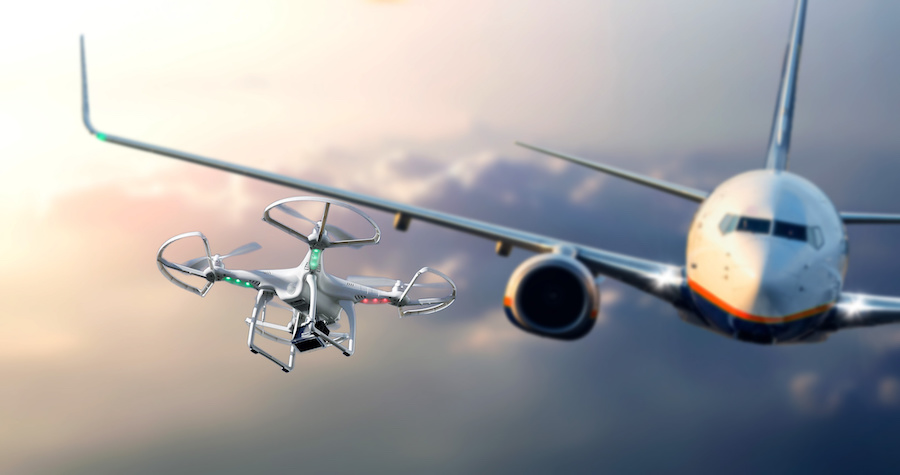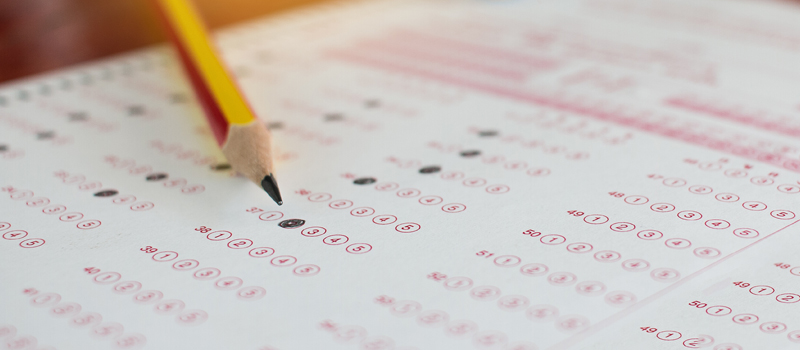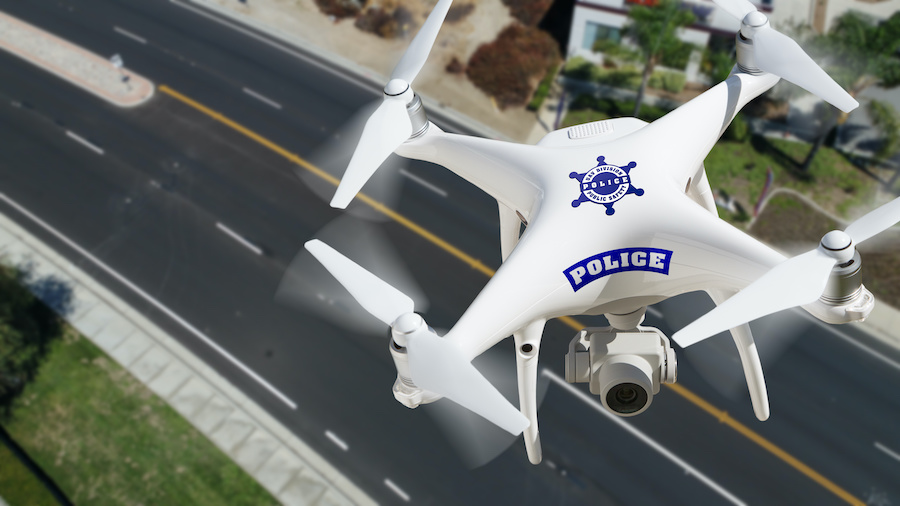-
Key Takeaways
-
What Are Heavy-Lift Drones?
- Definition and Capabilities
-
Top Heavy-Lift Drones in the Market
- Comparison Table of Top Drones
- GRIFF Aviation 300
- EHang EH216-S
- JOUAV CW-80E
- DJI FlyCart 30
- Draganfly Heavy Lift Drone
- Freefly Alta X
- T-DRONES M1200
- Matternet M2
-
Applications of Heavy-Lift Drones
- Cargo and Delivery
- Emergency Services
- Industrial Inspections
- Agriculture
-
Future of Heavy-Lift Drones
- Technological Advancements
- Regulatory Developments
-
Conclusion
Today’s heavy-lift UAVs can carry weighty cargo, multiple passengers, and even small vehicles. Drones capable of lifting nearly 500 lbs can transport materials, equipment, and goods across large distances and diverse terrain.
These heavy-lift drones are changing logistics, medical, transportation, and agricultural industries. Drones are no longer just for photography, as they can now carry heavy payloads essential for key market sectors.
Let’s explore the future of transport and how leading innovators are harnessing the power of heavy-lift UAVs.
Key Takeaways
- Heavy-lift UAVs can now carry payloads up to 498 lbs.
- They are helping revolutionize logistics, medical transport, disaster recovery and relief, and agriculture.
- The FAA is developing an air traffic control program for UAVs called Unmanned Aircraft System Traffic Management (UTM).
- Planning for evolving regulations will help companies integrate aerial delivery and logistics for greater future potential.
What Are Heavy-Lift Drones?
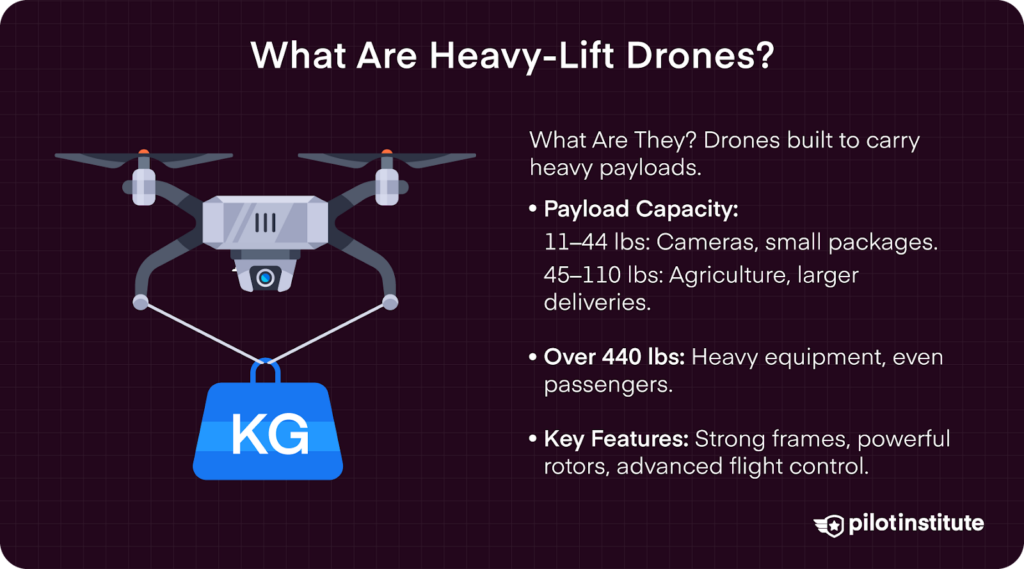
Heavy-lift drones are unmanned aerial vehicles (UAVs) specifically designed to carry substantial weights beyond the capacity of standard drones.
Definition and Capabilities
These drones typically have payload capacities ranging from 11 lbs (5 kg) to over 441 lbs (200 kg), and are used in industrial and other commercial applications.
Payload capacities of 11 lbs (5 kg) to 44 lbs (20 kg) are typically suitable for carrying professional cameras, small packages, or surveying equipment.
Meanwhile, those capable of carrying 45 lbs (20.5 kg) to 110 lbs (50 kg) payloads are Ideal for agricultural spraying, larger delivery items, and specialized sensors.
Heavy-lift drones capable of carrying over 440 lbs (200 kg) offer incredible options for transporting heavy equipment, small vehicles, and even human passengers.
These UAVs feature innovative features, such as robust frames made from carbon fiber or aluminum alloys and powerful propulsion systems with multiple rotors for increased stability.
Many also offer advanced flight control systems for precise maneuvering, obstacle avoidance, range, and landing precision.
Top Heavy-Lift Drones in the Market
Comparison Table of Top Drones
| Drone Model | Max Payload | Max Flight Time (Fully Loaded) | Use Case |
| Griff Aviation 300 | 496 lbs (226 kg) | 45 minutes | Industrial Lifting of Heavy Payloads |
| Ehang EH216-S | 485 lbs (219 kg) | 21 minutes | Urban Logistics, Transportation, and Management |
| JOUAV CW-80 | 110 lbs (49.89 kg) | 8-10 hours | Cargo Delivery Over Distances |
| DJI FlyCart 30 | 66 lbs (29.9 kg) | 18 minutes | Delivery Logistics |
| DragonFly Heavy Lift | 66 lbs (30 kg) | 18 – 55 minutes | Delivery Logistics, Surveillance, and Public Safety |
| Freefly Alta X | 35 lbs (16 kg) | 20-50 minutes | Mapping, Surveying, Cinematography, and Delivery |
| T-Drones M1200 | 11 lbs (5 kg) | 1 hour | Surveying and Mapping, Agricultural Monitoring |
| Matternet M2 | 4.4 lbs (2kg) | 15-30 minutes | Delivery Logistics |
GRIFF Aviation 300
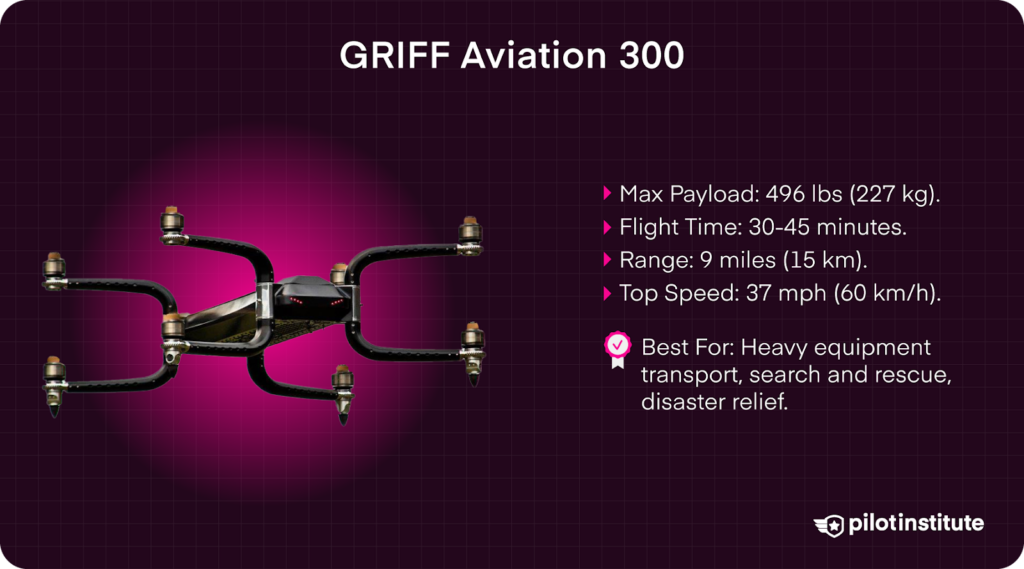
The Norwegian brand GRIFF produces the heaviest-lifting drone. GRIFF Aviation offers a modular design with its 300 series, tailored with impressive customizable payload options. Yet, it is not easily available. Interested pilots have to contact GRIFF Aviation for a special order. Pricing is listed at around $250,000.
Maximum Payload: 496 lbs (227 kg).
Flight Time: 30-45 minutes of flight, depending on payload.
Range: 9 miles (15 km) .
Top Speed: 37 mph (60 km/h).
Unique Features:
- An easy release battery system with single cell batteries, operable in extreme weather conditions and temperature.
- Maximum altitude of 100 meters (328 ft).
- GRIFF 2.0 Master Design allows for the easy and quick switching out of payloads.
- GRIFF Claw, a wireless cargo hook featuring a quick-release system.
- A 120° wide-angle camera (GRIFF Eye).
- Removable skis and sensors.
- Octocopter design provides stability and redundancy with eight rotors that can maintain flight and safely land with payloads, even if a motor or two loses power.
- It features waterproof construction and is suitable for harsh weather conditions.
- Waterproof construction.
- An optional mobile control station that allows pilots to fly by first-person view (FPV).
Best For: GRIFF’s 300 model is best suited for heavy equipment transport, where operations can move large machinery or construction materials to remote locations or over rough terrain.
Search and rescue missions are also a key use case scenario, as the GRIFF 300 can lift medical and other equipment. It is also a major asset for disaster relief operations.
EHang EH216-S
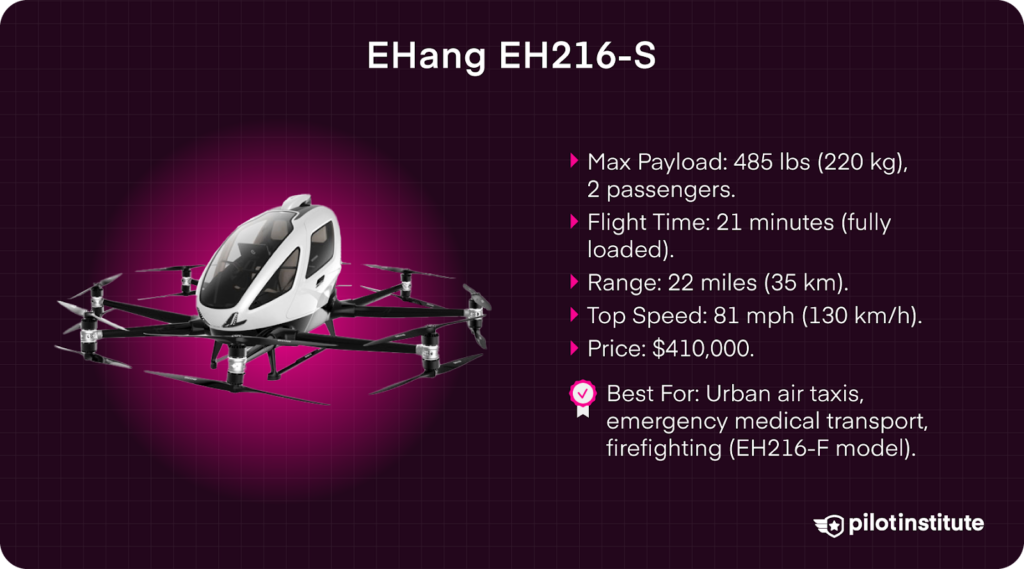
EHang calls the EH216-S a “pilotless passenger-carrying electric vertical take off and landing (eVTOL) aircraft.” It was awarded the world’s first certificate for single-passenger eVTOL from the Civil Aviation Administration of China (CAAC). However, the high price tag of $410,000 may be quite a barrier for many firms.
Maximum Payload: 485 lbs (220 kgs), capable of carrying up to two passengers.
Flight Time: 21 minutes (Fully Loaded).
Range: 22 miles (35 km).
Top Speed: 81 mph (130 km/h), with cruising speed of 62 mph (100 km/h).
Unique Features:
- Can fly in winds up to 44 mph (70 km/h).
- Recharging time of only 120 minutes.
- Maximum takeoff weight of 1,323 lbs (600 kg).
- Gull-wing doors open into an interior cabin that seats two, giving passengers a unique bird’s eye view during their journey.
- Air-conditioned cabin equipped with Wi-Fi.
- Fiberglass hull body to reduce weight without sacrificing strength.
- E-Ports that facilitate landing on small areas, like urban rooftops or water landing pads.
- Advanced safety systems with multiple redundancies and fail-safe mechanisms.
- Intelligent command systems offer incredible oversight and cluster operations management.
Best For: The EH216-S is best suited for urban air mobility, including air taxi services that will help reduce traffic congestion on the streets. The drone is also ideal for travel across waterways and island regions, making it a great option for aerial tourism.
The EH216-S is also key in emergency medical transportation, offering a rapid response for patient transfer or organ delivery operations.
There is even a version specifically for urban firefighting applications, the EH216-F, which provides strategic water distribution to fires in high-rise buildings. It can carry up to 40 gallons (150 liters) of water and is remotely dispatched for autonomous firefighting.
JOUAV CW-80E
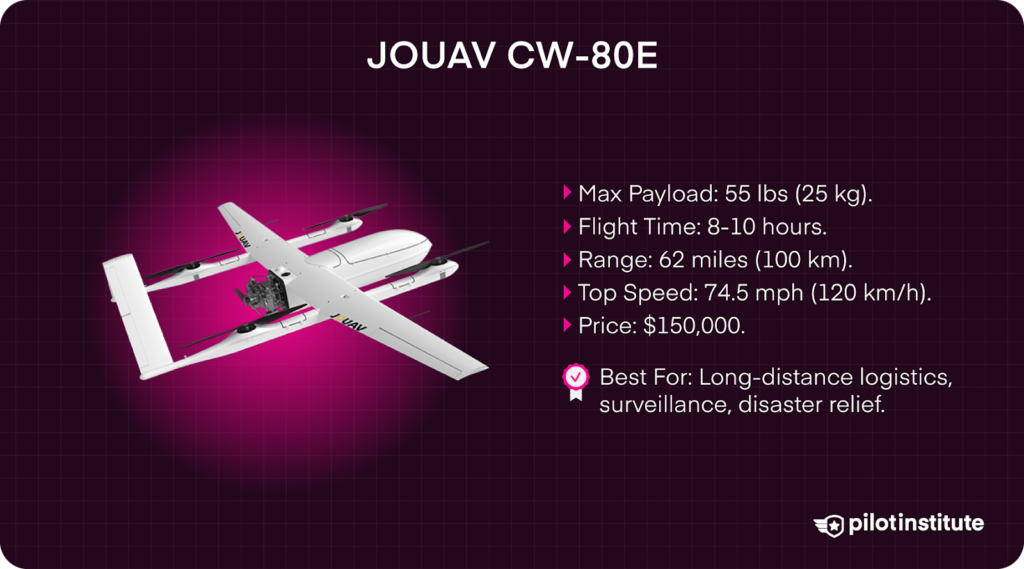
The JOUAV CW-80E offers a unique fixed-wing design with five propellers. Still, it comes with a high price tag of $150,000.
Maximum Payload: 55 lbs (25 kg).
Flight Time: 600 minutes, ranging around 8-10 hours.
Range: 62 miles (100 km).
Top Speed: 74.5 mph (120 km/h) with a cruising speed of 55.9 mph (90 km/h).
Unique Features:
- Wind resistance of 13.9 m/s, gusting 17 m/s.
- Maximum altitude of 6,000 meters.
- IP54 rating ensures that it is waterproof and built to withstand tough conditions.
- JOUAV’s Eagle Map system allows for the real-time monitoring of flight operations and data.
- LiDAR sensors for surveying the landscape and obstacle avoidance.
- Designed to operate in extreme temperatures, from -4° F (-20° C) to 131° F (55° C).
- Modular design makes it easy to swap payloads, including several different types of camera systems for precision mapping and surveillance.
- Clear video feed at long distances, up to 124 miles (200 km).
- Dual GNSS tracks satellites on multiple frequencies to ensure accuracy. There is also advanced data encryption to protect delicate flight data and video transmission.
Best For: This is a great option for long-distance logistics, surveillance operations, and disaster relief efforts. Its long range is unmatched in the industry.
DJI FlyCart 30
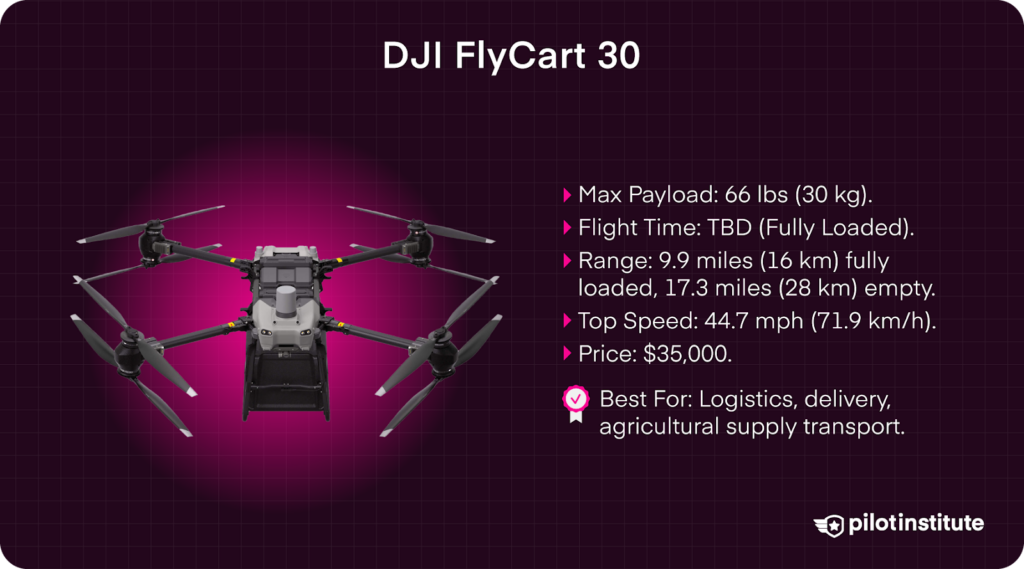
DJI is known for its intelligent flight modes, and the FlyCart 30 is no different. The DJI FlyCart 30 has impressive cargo and winch modes, with versatile payload configurations for different delivery needs.
Winch mode works with a retractable cable that is controlled both manually and automatically. DJI FlyCart 30 automatically adjusts its altitude to minimize the swing of the cargo on the cable.
Fully equipped, the FlyCart 30 is priced around $35,000.
Maximum Payload: 66 lbs (30kg).
Flight Time: 18 minutes (Fully Loaded).
Range: 17.3 miles (28 KM) without a payload and 9.9 miles (16 km) with a full payload.
Top Speed: 44.7 mph (71.9 km/h), with a cruising speed of 33.5 mph (53.9 km/h).
Unique Features:
- Dual batteries that can be used together to increase power capacity, or one at a time to increase max payload weight to 88 lbs (40 kg).
- Capable of 12.4 miles (20 km) video range that can be extended even further with a DJI Cellular Dongle, featuring 4G enhanced video transmission.
- 6,000 m max flight altitude.
- Can handle extreme weather, down to -4° F (-20° C) to 113° F (45° C), with a wind speed resistance of 12 m/s.
- IP55 rating.
- Integrated parachute for safe landing in emergencies.
- Cruise control helps reduce flight fatigue.
- AR Projection ensures precise landing and cargo delivery.
- Dual operator mode allows for multiple pilots.
- Delivery mode automatically controls the winch and displays the cargo status.
- DJI Pilot 2 or DJI DeliveryHub allows users to preplan complex routes with a 2.5D map.
Best For: This is a heavy hitter for logistics and delivery applications. It offers efficient transportation of goods in urban and rural areas.
It also shines in agricultural supply transport, delivering supplies directly to farms or fields.
Draganfly Heavy Lift Drone
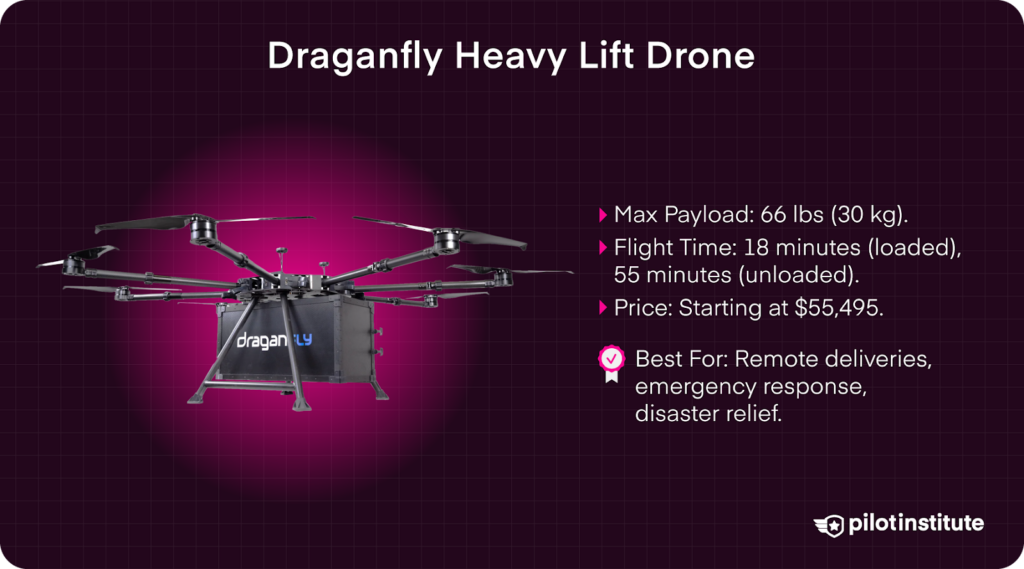
Like the DJI FlyCart 30, the Draganfly Heavy Lift Drone has a modular payload design that makes it easy to switch between equipment. The drone can even combine multiple payloads to mix delivery systems and sensor combinations. The unit is priced starting at $55,495.
Maximum Payload: 66 lbs (30 kg).
Flight Time: 18 minutes (Fully Loaded), 55 minutes (Unloaded).
Range: 18.65 miles (30 km).
Top Speed: 49.2 mph (64.69 km/h).
Unique Features:
- BVLOS-capable for users with proper FAA approval.
- Simple hull design with customizable payload options.
- Gremsy VIO offers a 4K zoom sensor and a radiometric thermal camera.
- A 2,400 m laser rangefinder, which can extend the drone’s range by 6.2 miles (10 km) with the DTC BluSDR antenna.
- Equipped with a triple-redundant inertial measurement unit (IMU).
- Made in the United States.
- Blue UAS Certified, meaning it is Department of Defense approved.
Best For: This is a great option for aerial delivery applications, such as transporting goods to remote locations.
It is also well-suited for emergency response and disaster relief, such as supplying essential items during times of crisis. Its Blue UAS Certification keeps these sensitive operations secure.
Freefly Alta X
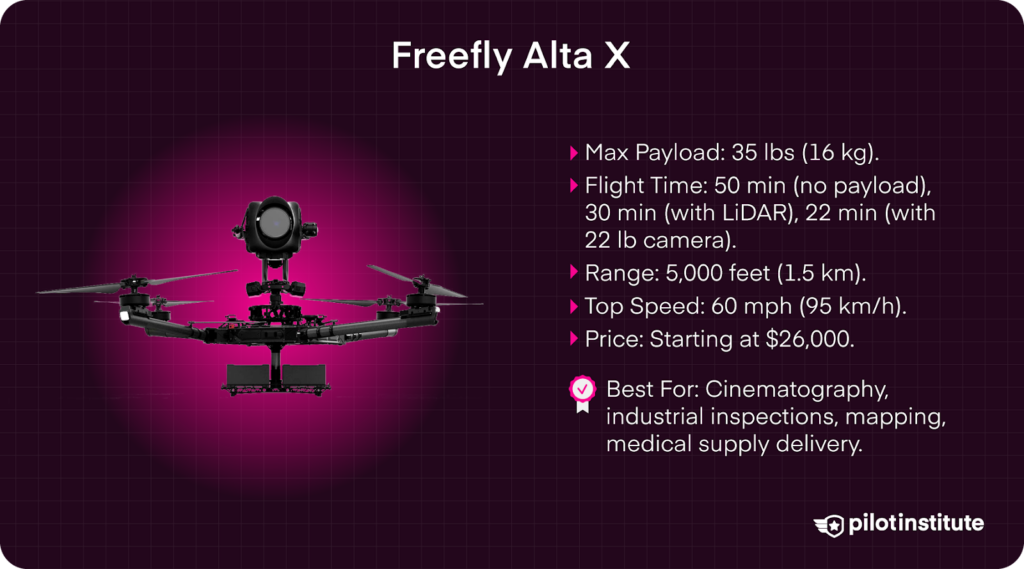
Freefly’s Alta X can carry camera equipment, sensors, and mapping gear. It has an innovative modular and folding design that allows for easy transportation and quick deployment. The Alta X is affordable compared to some other options on this list, starting at $26,000.
Maximum Payload: 35 lbs (16 kg).
Flight Time: 50 minutes of flight time with no payload, 30 minutes with the 11 lb Phoenix LiDar sensor, and 22 minutes of flight time with the 22 lb Mōvi CARBON Panasonic BS1H camera mounted on a 5-axis gimbal.
Range: 5,000 feet (1.5 km).
Top Speed: 60 mph (95 km/h).
Unique Features:
- Alta ActiveBlade design helps with vibration, reducing it by 1/5th to allow for clear photography and data collection.
- Offers both top and bottom payload mounting.
- Everything is designed and assembled in the USA at the FreeFly headquarters in Washington State, ensuring protection from tariffs or security concerns with foreign drones.
- Folds to half its size for easy transport.
- DC expansion ports to power unique payloads.
- MAVSDK API software allows for easy remote control.
- Multiband RTK system for more precise GPS tracking.
- A wide variety of camera payloads, including LiDAR sensors, mapping cameras, Mōvi CARBON Panasonic BS1H camera, LED lights, and a 4K 1000 FPS high-speed camera.
Best For: The Freefly Alta X is designed to carry camera equipment as its main payload. As such, it is well-suited for cinematography and aerial photography for high-quality film production.
It also serves industrial inspections with ease, accessing hard-to-reach areas with specialized equipment.
Additionally, it is often used in agricultural, mapping, and medical supply delivery applications.
T-DRONES M1200

The T-Drones M1200 offers a payload capacity of 11 lbs (5kg). T-Motors’ option is also the most affordable on our heavy hitters’ list, being between $3,699 and $5,098.
Maximum Payload: 11 lbs (5 kg).
Flight Time: 68 minutes (Unloaded).
Range: 18.6 miles (30 km).
Top Speed: 33.5 mph (53.9 km/h).
Unique Features:
- Advanced propulsion system with patented T-Motor carbon props that ensure efficient power usage and stability.
- Aluminum hollow body folds into itself for ultimate protection and portability.
- Multiple payload support compatible with a thermal camera, laser night vision camera, cargo box, winch system, or searchlight.
- Flexible connector to easily attach whatever payload is needed.
- Additional power supply interfaces to power payloads.
- Easily automate flight paths with intelligent waypoint settings.
- Three types of landing gear for precise landing in diverse environments.
Best For: The M1200 is great for surveying and mapping, as it can cover large areas without frequent battery changes.
It is also impressive for agricultural monitoring applications, collecting data over extensive farmland.
Matternet M2
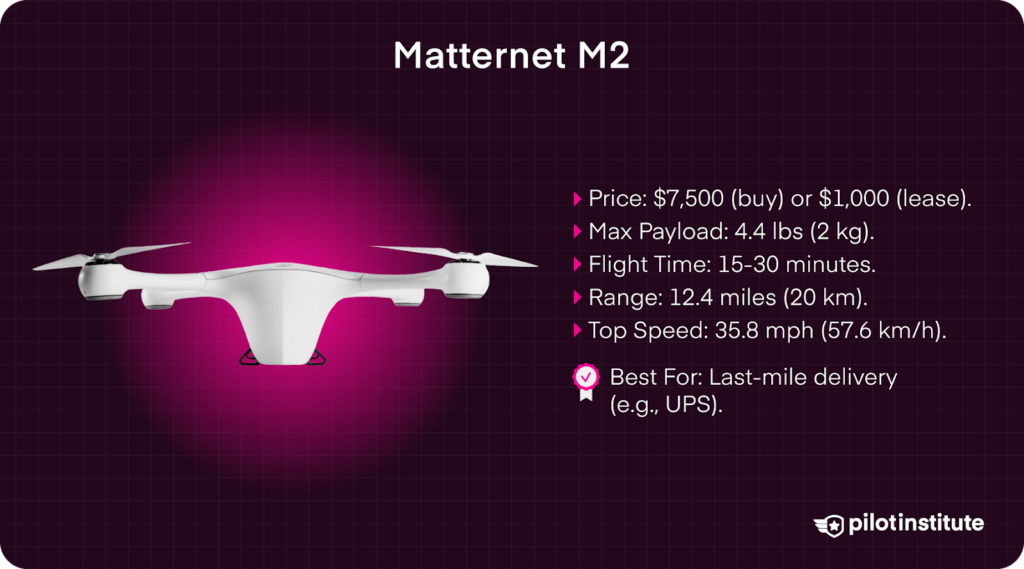
The final option on our list is the Matternet M2. Purchase options start at $7,500, and leasing options start at $1,000.
Maximum Payload: 4.4 lbs (2 kg).
Flight Time: 15 to 30 minutes of flight time, depending on payload.
Range: 12.4 miles (20 km).
Top Speed: 35.8 mph (57.6 km/h).
Unique Features:
- Designed to operate from 0° F (-17.7° C) to 113° F (45° C).
- Wind resistance of 8 m/s, gusting 12 m/s.
- Uses 4G LTE cellular bands B2, B4, and B17 for accuracy and constant connection.
- Easy battery, payload swapping capabilities.
- Tether drop system for payload deliveries in private spaces.
Best For: Matternet’s M2 is the top option for delivery services like UPS. Its lower price and functionality make it a great fit for last-mile delivery logistics.
Applications of Heavy-Lift Drones
Cargo and Delivery
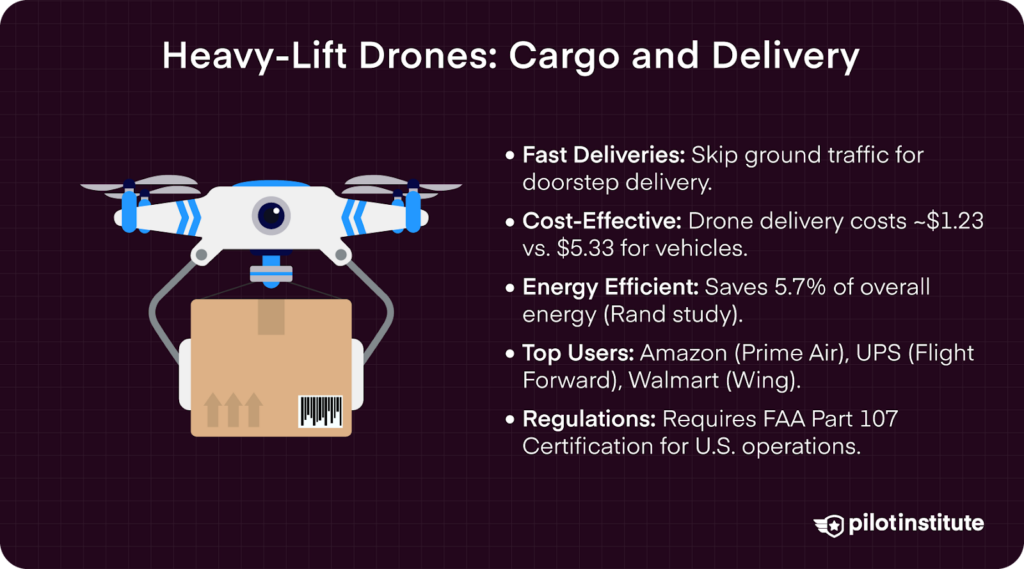
Heavy-lift drones are typically used in last-mile delivery, which is essentially the final leg of the delivery process when items are delivered to the consumer’s doorstep. Drones reduce delivery times by bypassing ground traffic.
Such drones also lower operational costs compared to traditional delivery methods.
A study published in Transportation Research Part D: Transport and Environment found significant cost savings when using drones in delivery services. Drone deliveries typically see costs of around $1.23 per delivery, which is a stark difference from the $5.33 cost of deliveries conducted by electric vehicles.
There is also less energy used in drone deliveries. Timothy R. Gulden from Rand conducted research on the energy savings seen in drone delivery systems. The study found that transitioning even just 20% of deliveries from vehicles to drones would result in a savings of 5.7% of the “overall energy used.”
Companies employing such drones do so under a Part 107 Certification.
According to the FAA’s Advisory Circular 107- 2A, “Part 107 permits transportation of property by small unmanned aircraft for compensation or hire.
These operations must be conducted within a confined area and in compliance with the operating restrictions of part 107. When transporting property, the transport must occur wholly within the bounds of a single State.” (AC 107-2A, Chapter 5, Section 15).
Today, top logistics companies like Amazon and UPS are exploring drone delivery systems. Amazon’s Prime Air first got FAA approval in 2020, when it received an Air Carrier Certificate. Amazon received further FAA approval in 2024 to expand BVLOS operations using its own onboard detect-and-avoid technology.
UPS’ Flight Forward also received Part 135 Certification, allowing its drones to fly BVLOS. Its fleet consists of Matternet’s M2.
Walmart’s Wing Drone Delivery is also making headway in gaining FAA approval. Yet, the program has not received permanent certification for BVLOS operations, limiting its scalability.
Emergency Services
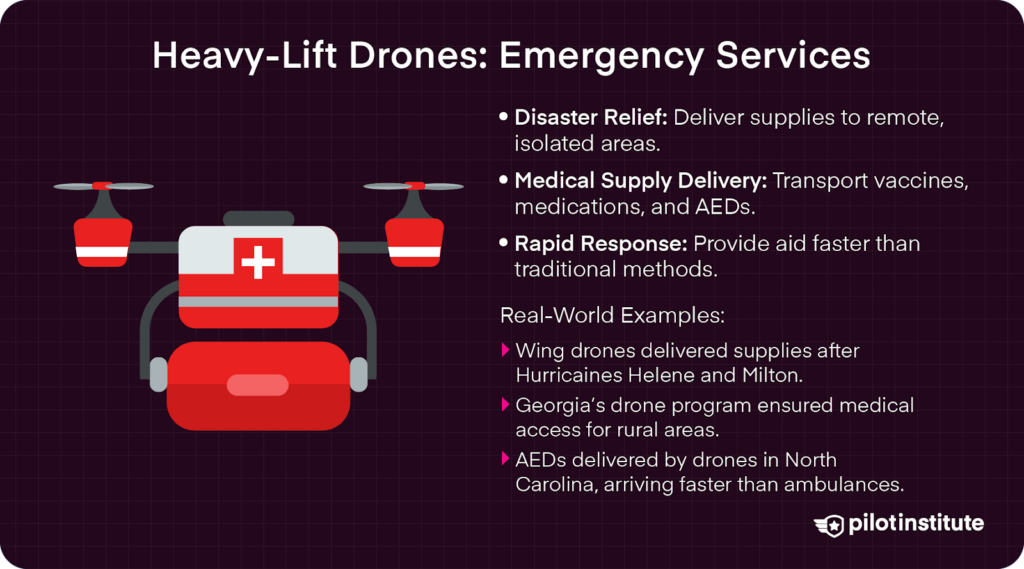
With their long ranges, these drones can also reach remote areas and provide essential services to isolated communities. Drones capable of carrying heavy payloads can greatly help disaster relief operations by offering a rapid assessment of damage and identification of survivors.
They can also deliver critical supplies when traditional routes are impassable, ensuring that much-needed medical supplies and resources are delivered to rural areas hit by disaster, such as mountainous regions.
Hurricane Helene and Milton
For example, drones provided a critical delivery lifeline for the rural communities hit by Hurricanes Helene and Milton. The FAA granted temporary BVLOS approval for Wing, Walmart’s drone delivery program, which served as a lifeline to rural communities isolated in the hurricane’s aftermath.
Medical supply delivery is another key application that will benefit from more heavy-lift drone use. This includes operations like transporting life-saving medications, vaccines, or equipment. Deliveries of vaccines via drones were also critical during the COVID-19 pandemic.
Health Innovations
For example, the Georgia Rural Health Innovation Center implemented a pilot drone delivery program to ensure medical deliveries to rural Georgia regions. They found that drone delivery was an efficient way to deliver medications to rural homes.
They can also support telemedicine by delivering diagnostic tools. One example is the drone deployment of AEDs (Automated External Defibrillators) in emergencies.
According to the National Heart, Lung, and Blood Institute, researchers in North Carolina are testing the drone delivery of AED systems following emergency 911 calls.
AEDs arrive between 5 and 8 minutes after the 911 call, which is often much faster than how quickly first responders can get to emergency scenes. The devices are lowered by a tether to 911 callers to administer in cases of cardiac arrest.
Drones have also played an active role in the delivery of humanitarian aid in remote areas or regions experiencing conflict. There is the example of Critical Care by Air in Africa that provides medical supplies and humanitarian aid via drone deliveries.
Industrial Inspections
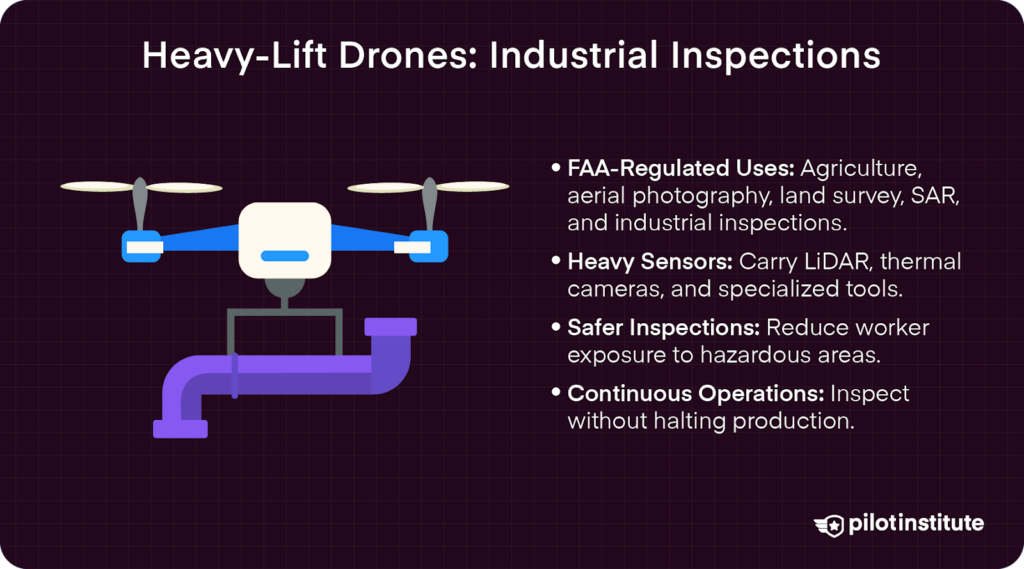
The FAA allows the use of large drones in “Agricultural survey and spraying, Aerial photography, Land survey and inspection, Inspection of structures, Search and Rescue (SAR) operations.” (AIM, Chapter 11, Section 3).
Industrial inspections often require heavy sensors and other equipment. With the increasing payload capacities of heavy-lift drones, it is much more feasible to carry LiDAR scanners, thermal cameras, or other specialized tools. This makes it more efficient in inspecting infrastructure like bridges, pipelines, and wind turbines.
Such inspections minimize the need for human workers in hazardous locations. Heavy-lift drones have been used in mining operations, where drones can inspect the integrity of tunnel walls with complex sensors and surveying equipment.
Drones can extrapolate detailed data with high-resolution sensors. This also reduces downtime by performing inspections without halting operations.
Agriculture
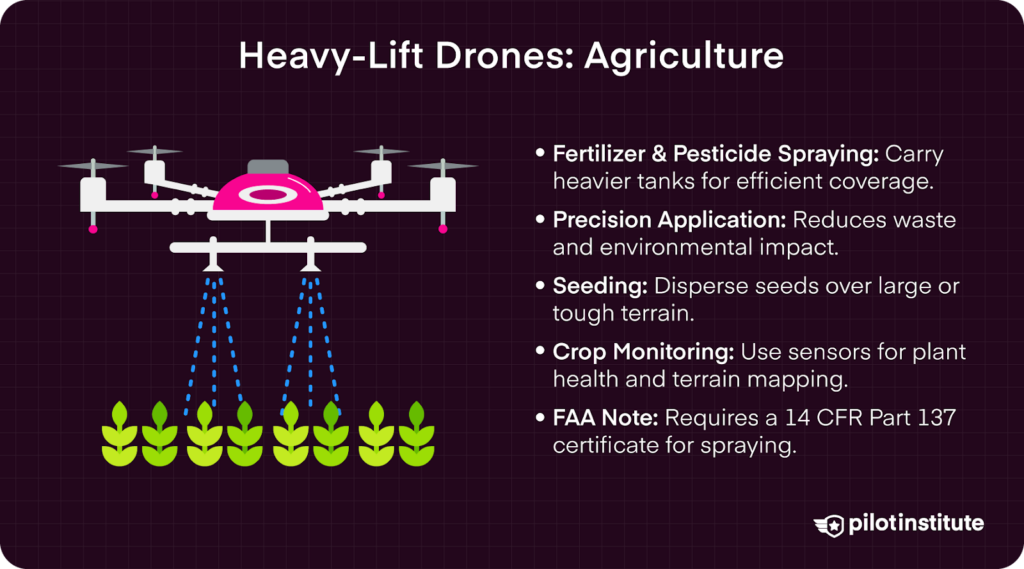
Heavy-lift drones help increase efficiency in the agricultural spraying of fertilizers and pesticides. Many options have the ability to carry heavier tanks or multiple types of agrichemicals.
Moreover, precision application reduces waste and environmental impact, while less frequent refills increase operational efficiency.
Drones can also work to increase the efficiency of seeding by dispersing seeds over large or difficult terrain. Carrying advanced sensors allows crop monitoring for plant health analysis and terrain mapping.
It is important to note that according to the FAA, “Civil agricultural spraying operations will also require a 14 CFR Part 137 certificate; see paragraph 11-4-5, Airspace Access for 14 CFR Part 135 and 14 CFR Part 137.” (AIM, Chapter 11, Section 3).
Future of Heavy-Lift Drones
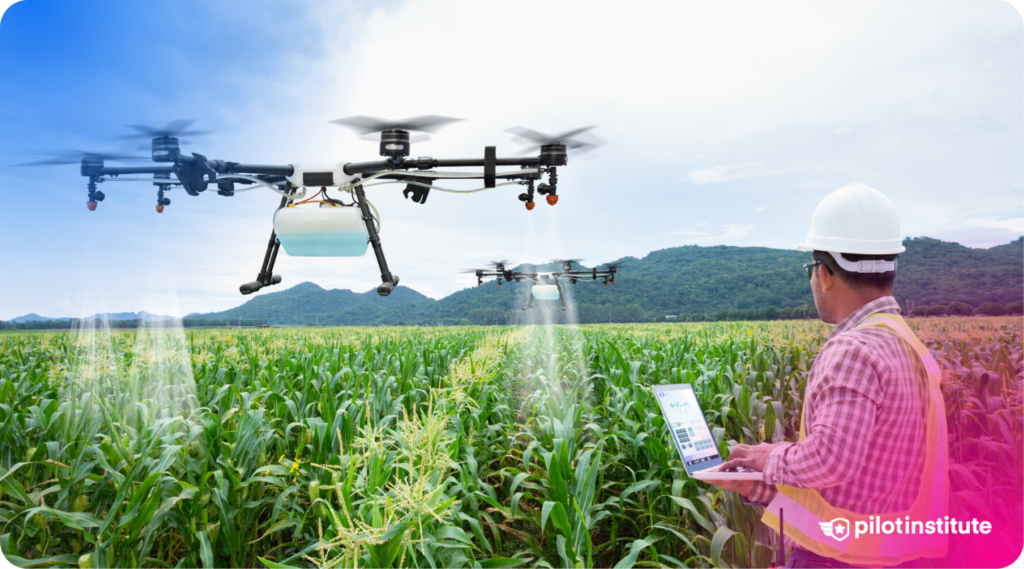
Technological Advancements
As technology advances, so will increases in payload capacities. We will also likely see the development of stronger, lighter materials like advanced composites. Improvements in motor and propeller efficiency will increase payload capacity and range.
There is also great potential in innovations in battery technologies. With greater adoption of hydrogen fuel cells and hybrid power systems, drones will see enhanced battery density, leading to longer flight times.
Continuing innovations in artificial intelligence will advance the autonomous capabilities of drones in the heavy-lifting category. More advanced AI models will lead to smarter drones capable of complex decision-making and adaptable intelligent flight operations.
Many expect innovations in fleet operations as well, with swarm communications to coordinate large-scale operations.
Regulatory Developments
First, it is important to review the current FAA regulations that apply to heavy-lift drone operations. All drone operators in this category must have Part 107 certification, which is applicable for drones under 55 lbs to fly in commercial applications.
Additionally, many use cases will need a Part 135 Certification, which regulates aircraft used in commercial applications, including drone delivery applications.
As these drones will be involved with the delivery of goods, they are considered air carriers under FAA rules. Part 135 Certification unlocks greater capabilities than Part 107 flight operations.
There is also Part 91, which regulates specifically for applications like agricultural spraying activities. This regulates the transportation of hazardous materials, such as pesticides.
Evolving regulations will continue to shape how drone delivery and heavy-lifting operations will play out in the future.
The FAA is currently developing an Unmanned Traffic Management (UTM) system for more efficient airspace integration. This is essentially an air traffic control system for drones that will focus on coordinating large-scale operations in crowded low-altitude environments, like urban areas.
The program may require additional steps in operations, such as requirements for communicating a drone’s location and flight path.
Yet, doing so will offer enhanced collision avoidance technologies to support large-scale operations like delivery services in mixed airspace.
Conclusion
Heavy-lift drones are rapidly advancing, offering solutions that enhance efficiency, safety, and accessibility across various industries.
Understanding the capabilities and applications of these drones can help organizations leverage technology for competitive advantage.
Heavy-lift drones can benefit delivery and logistics for companies in a wide variety of industries. It may be beneficial to explore partnerships with drone manufacturers or service providers to expand your delivery and logistics operations to new heights—literally.
As technology continues to evolve, heavy-lift drones will play a pivotal role in shaping the future of logistics, emergency response, and beyond, proving that the sky is not the limit but just the beginning.

